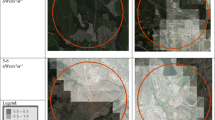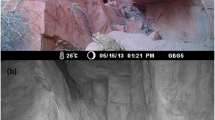Abstract
We examined environmental correlates of activity in the Freckled Nightjar (Caprimulgus tristigma), a nocturnal aerial insectivore that is resident year-round in the colder and drier parts of southern Africa. Specifically, we tested the prediction that air temperature (T a), in addition to light availability, is a significant correlate of Freckled Nightjar activity. We found that aerial insect density varied by over three orders of magnitude (from <1.0 to 117.1 insects 1,000 m−3) during the course of the study, and was strongly and positively related to T a. Nightjar activity was also significantly temperature-dependent, with a cessation of activity at T a < 12°C. Consistent with previous studies, we found that activity levels were strongly related to ambient light, with markedly reduced activity levels on dark nights. The average number of Freckled Nightjars encountered per 14.6-km transect was 1.95 ± 2.44 nightjars transect−1 during nights near full moon, but only 0.17 ± 0.61 nightjars transect−1 around new moon. Our study reveals that caprimulgid activity can be significantly influenced by temperature as well as ambient light.



Similar content being viewed by others
References
Bartholomew GA, Howell TR, Cade TJ (1957) Torpidity in the white-throated swift, anna hummingbird, and poor-will. Condor 59:145–155
Brigham RM (1992) Daily torpor in a free-ranging goatsucker, the common poorwill (Phalaenoptilus nuttallii). Physiol Zool 65:457–472
Brigham RM, Barclay RMR (1992) Lunar influence on foraging and nesting activity of Common Poorwills (Phalaenoptilus nuttallii). Auk 109:315–320
Brigham RM, Gutsell RCA, Wiacek RS, Geiser F (1999) Foraging behavior in relation to the lunar cycle by Australian Owlet-nightjars (Aegotheles cristatus). Emu 99:253–261
Brigham RM, Körtner G, Maddocks TA, Geiser F (2000) Seasonal use of torpor by free-ranging Australian owlet-nightjars (Aegotheles cristatus). Physiol Biochem Zool 73:613–620
Brigham RM, Woods CP, Lane JE, Fletcher QE, Geiser F (2006) Ecological correlates of torpor use among five caprimulgiform birds. Acta Zool Sinica 52(suppl):401–404
Cleere N (1999) Family Caprimulgidae (nightjars). In: del Hoyo J, Elliot A, Sargatal J (eds) Handbook of the birds of the world, vol 5. Lynx, Barcelona, pp 302–386
Dawson WR, Fisher CD (1969) Responses to temperature by the spotted nightjar (Eurostopodus guttatus). Condor 71:49–53
Fletcher QE, Fisher RJ, Willis CKR, Brigham RM (2004) Free-ranging common nighthawks use torpor. J Therm Biol 29:9–14
Holyoak DT (2001) Nightjars and their allies: the Caprimulgiformes. Oxford University Press, Oxford
Jackson HD (1973) Records of some birds and mammals in the central Chimanimani Mountains of Moçambique and Rhodesia. Durban Mus Novit 9:23–42
Jackson HD (2000) Prey size in relation to mouth size of nightjars in Zimbabwe. Ostrich 71:436–437
Jackson HD (2003) A review of foraging and feeding behaviour, and associated anatomical adaptations, in Afrotropical nightjars. Ostrich 41:187–204
Jetz W, Steffen J, Linsenmair KE (2003) Effects of light and prey availability on nocturnal, lunar and seasonal activity of tropical nightjars. Oikos 103:627–639
Körtner G, Brigham RM, Geiser F (2000) Winter torpor in a large bird. Nature 407:318
Lane JE, Brigham RM, Swanson DL (2004a) Daily torpor in free-ranging whip-poor-wills (Caprimulgus vociferus). Physiol Biochem Zool 77:297–304
Lane JE, Swanson DL, Brigham RM, McKechnie AE (2004b) Physiological responses to temperature by Whip-poor-wills: more evidence for the evolution of low metabolic rates in caprimulgiformes. Condor 106:921–925
McKechnie AE, Ashdown RAM, Christian MB, Brigham RM (2007) Torpor in an Afrotropical caprimulgid, the Freckled Nightjar (Caprimulgus tristigma). J Avian Biol 38:261–266
Mills AM (1986) The influence of moonlight on the behavior of goatsuckers (Caprimulgidae). Auk 103:370–378
Racey PA, Swift SM (1985) Feeding ecology of Pipistrellus pipistrellus (Chiroptera, Vespertilionidae) during pregnancy and lactation. I. Foraging behavior. J Anim Ecol 54:205–215
Rydell J, Entwistle A, Racey PA (1996) Timing of foraging flights of three species of bats in relation to insect activity and predation risk. Oikos 76:243–252
Sibley CG, Ahlquist JE (1990) Phylogeny and classification of birds. Yale University Press, New Haven
Speakman JR Rydell J, Webb PI, Hayes JP, Hays GC, Hulbert IAR, McDevitt RM (2000) Activity patterns of insectivorous bats and birds in northern Scandinavia (69°N), during continuous midsummer daylight. Oikos 88:75–86
Spottiswoode CN, Jackson HD (2005) Freckled nightjar. In: Hockey PAR, Dean WRJ, Ryan PG (eds) Roberts birds of southern Africa. The Trustees of the John Voelcker Bird Book Fund, Cape Town
Woods CP, Brigham RM (2008) Common poorwill activity and calling behavior in relation to moonlight and predation. Wilson J Ornithol (in press)
Acknowledgments
We sincerely thank Alecia Kirton for her invaluable statistical advice, and Richard Newbery, Idah Mathe, Linda Marcus and the rest of the staff of Kgaswane Mountain Reserve for their support. Our thanks also go to Nikki Fisher, Tony Ashdown, Kay Fisher, Justin Phama, Gareth Borman, and Hlengiwe Mbatha. Tom Rogers of Lynx Optics, Johannesburg, kindly provided discounted spotlighting equipment. Mark Brigham provided helpful advice and insightful comments on the manuscript, and we benefited greatly from discussions with Walter Jetz and Marcus Byrne. This project was facilitated by funding from the University of the Witwatersrand (Friedel Sellschop Award) and the DST/NRF Centre of Excellence at the Percy Fitzpatrick institute to A.E.M. All procedures were approved by the University of the Witwatersrand Animal Ethics Screening Committee and comply with current South African laws.
Author information
Authors and Affiliations
Corresponding author
Additional information
Communicated by T. Friedl.
Rights and permissions
About this article
Cite this article
Ashdown, R.A.M., McKechnie, A.E. Environmental correlates of Freckled Nightjar (Caprimulgus tristigma) activity in a seasonal, subtropical habitat. J Ornithol 149, 615–619 (2008). https://doi.org/10.1007/s10336-008-0309-7
Received:
Revised:
Accepted:
Published:
Issue Date:
DOI: https://doi.org/10.1007/s10336-008-0309-7




